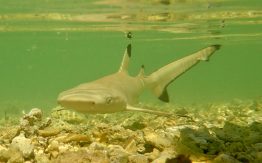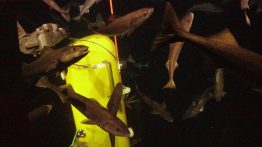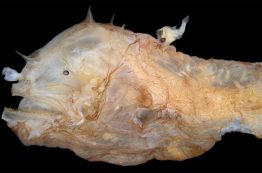In a first-of-its-kind study published in Nature, scientists report on the conservation status of reef shark populations worldwide. The results are grim; reef sharks have become rare at numerous locations that used to be prime habitat, and in some cases sharks may be absent altogether. A long history of human exploitation is the culprit, with depleted shark populations strongly tied to socio-economic conditions, lack of governance and the proximity of reef environments to large human population centers.
Read more »Big ships and underwater robots: heading out to sea with the Ocean Observatories Initiative
It’s summertime, and that means scientists across the University of Washington College of the Environment are in the field collecting data. Researchers in the School of Oceanography are no different and are working off the Oregon coast on their annual expedition to maintain the long-running cabled ocean observatory. Part of the broader National Science Foundation’s Ocean Observatories Initiative (OOI), UW oversees the Regional Cabled Observatory that spans several sites in Pacific Northwest waters, ranging from shallow coastal locales to deeper waters in the open ocean more than 300 miles offshore.
Read more »New studies show how to save parasites and why it’s important
Parasites have a public relations problem. Unlike the many charismatic mammals, fishes and birds that receive our attention (and our conservation dollars), parasites are thought of as something to eradicate — and certainly not something to protect. But only 4% of known parasites can infect humans, and the majority actually serve critical ecological roles, like regulating wildlife that might otherwise balloon in population size and become pests.
Read more at UW News »Deep-sea anglerfishes have evolved a new type of immune system
Deep-sea anglerfishes employ an incredible reproductive strategy. Tiny dwarfed males become permanently attached to relatively gigantic females, fuse their tissues and then establish a common blood circulation. In this way, the male becomes entirely dependent on the female for nutrient supply, like a developing fetus in the womb of a mother or a donated organ in a transplant patient. In anglerfishes, this unusual phenomenon is called “sexual parasitism” and contributes to the reproductive success of these animals living in the vast space of the deep sea, where females and males otherwise rarely meet.
Read more at UW News »Expert FAQ: Wildfires in the Pacific Northwest during the COVID-19 pandemic
Forest fires are one of nature’s oldest land management tools. For more than 10,000 years, Indigenous people in the Pacific Northwest have harnessed the power of fire to control the threat of destructive wildfires and encourage new growth across landscapes. In recent centuries, as the number of people living in forested areas has increased and large amounts of fuel have built up over years of suppression, large seasonal wildfires are becoming more common.
Read more at UW News »





